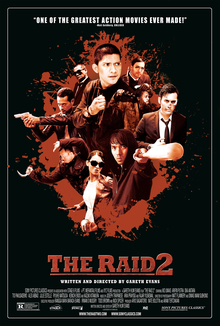Now with less subtitle!
I was at friend’s apartment when his roommate emerged from
his room with a face of satisfied exasperation. “What did you watch?” my friend
asked. “The Raid,” the roommate said.
Only a couple months later, the movie showed up in the Redbox near my
apartment. I rented it, and then never returned it. They charged me full price
for the movie. I was okay with that.
The Raid 2 I will
be returning to the Redbox, but I hope to buy it later. As a sequel, it does
everything it should: expands the scope of the film by upping the blood, multiplying
the cast, and leaving the setting of the original. There are moments in the
first movie that might make you cringe, but there are scenes that could make
you outright queasy. And there’s a lot of them. For instance, in the The Raid, there’s a part where our
protagonist Rama hides behind a wall from a machete-wielding thug. Suspicious
of what might hide behind the wall, the thug stabs randomly. One stab grazes
Rama’s cheek, and Rama must then wipe the blood off the blade as it’s retracted
not to give away his presence. It’s a scene that works on multiple levels, but
most importantly the fact that this is a wound that people can relate to. It’s
not a terribly deep cut, and the pain is familiar enough that it might recall a
memory to a previous cut. Cue the cringe.
None of that occurs in The
Raid 2. The violence here is gritty but borderline fantastical compared to
that of the original. It seems outrageous at times, but it’s mesmerizing to
watch. There’s a scene in which a woman wearing sunglasses armed with two claw
hammers takes out at least six men with Japanese daggers. The camerawork is intimidate
since we’re on a subway train, and the woman makes liberal use of the claw side
of the hammer. As you can guess, blood comes out in buckets during this scene,
and it lasts all of about a couple minutes. The sounds, the close-ups of hammer
claws buried into necks are harder to watch than in the first movie. Then
again, The Raid 2 is more dangerous.
The stakes are higher.
The Raid 2 is an
immediate continuation of the first film. The traitor of the first film is seen
at its beginning, and Rama is convinced to assist a cop with infiltrating a
mob. His only qualifications for this are that he can kick a metric ton of
asses and that he came out mostly unharmed from the titular raid of the first
film. Of course, the cop makes a deal Rama can’t refuse: he’ll protect Rama’s
wife and son. The wife is pregnant at the beginning of the first film. Rama is
established as a family man both in trying to retrieve his gangster brother and
saying reserved goodbyes to his pregnant wife. The family man angle is turned
against him in The Raid 2, which
makes Rama’s plight all the more engaging.
There’s even a running theme of distant fathers throughout
the movie, as Uco vies desperately for his gangster father’s approval, a shabby
hitman wants to reconnect with his son, and Rama stays in quiet contact with
his wife. Due to this desire to introduce more plot and conflict, the film
suffers at time in its pacing. At nearly two and a half hours, it’s a gamble to
increase the exposition in a film that about dudes beating up other dudes, and
the moments of downtime takes away that breakneck pace that we get in the
original film. Also, dad conflicts are too convenient for a movie like this,
but it helps to emphasize Rama’s concerns about staying alive long enough to be
a dad.
Beyond fatherhood, Rama also evolves in fighting style. He
takes on the persona of Yuda, a young hood who ends up in prison kicking the
crap out of someone. He then befriends Uco, the heir of a crime family in
Jakarta, in an attempt to infiltrate Uco’s syndicate. When not fighting, Rama
comes across as an earnest worker doing the best that he can. However, when
locked in combat, he becomes more brutal, nearly sadistic, than we see in the
first film. In The Raid, he’s
fighting for survival. In The Raid 2,
there’s something else. It’s never clear if this propensity to violence is merely
him maintaining his façade of Yuda, but it’s clear that we have a different
Rama than in the first movie.
In spite of the film’s iffy pacing, The Raid 2 must be praised for its cinematography. Color palettes
are played with in a noticeable and intriguing way. One setting in particular
is saturated with red, giving the impression that the film is culminating to a
bloody conclusion, which is accurate. That camera work has its moments of
shakiness but it’s never in a nauseating way. There is, however, a car chase
that does some bold moves with camera work in which the camera seems to fly
into the passenger seat of a car but from a great distance in front of that
car. A moment like that car chase reminds me why I was excited about the movie.
The Raid 2 is the bigger, badder
sequel that we thought we wanted. It’s still immensely fun to watch, but in
trying to make more plot, it loses the charming relentlessness of the original.

No comments:
Post a Comment